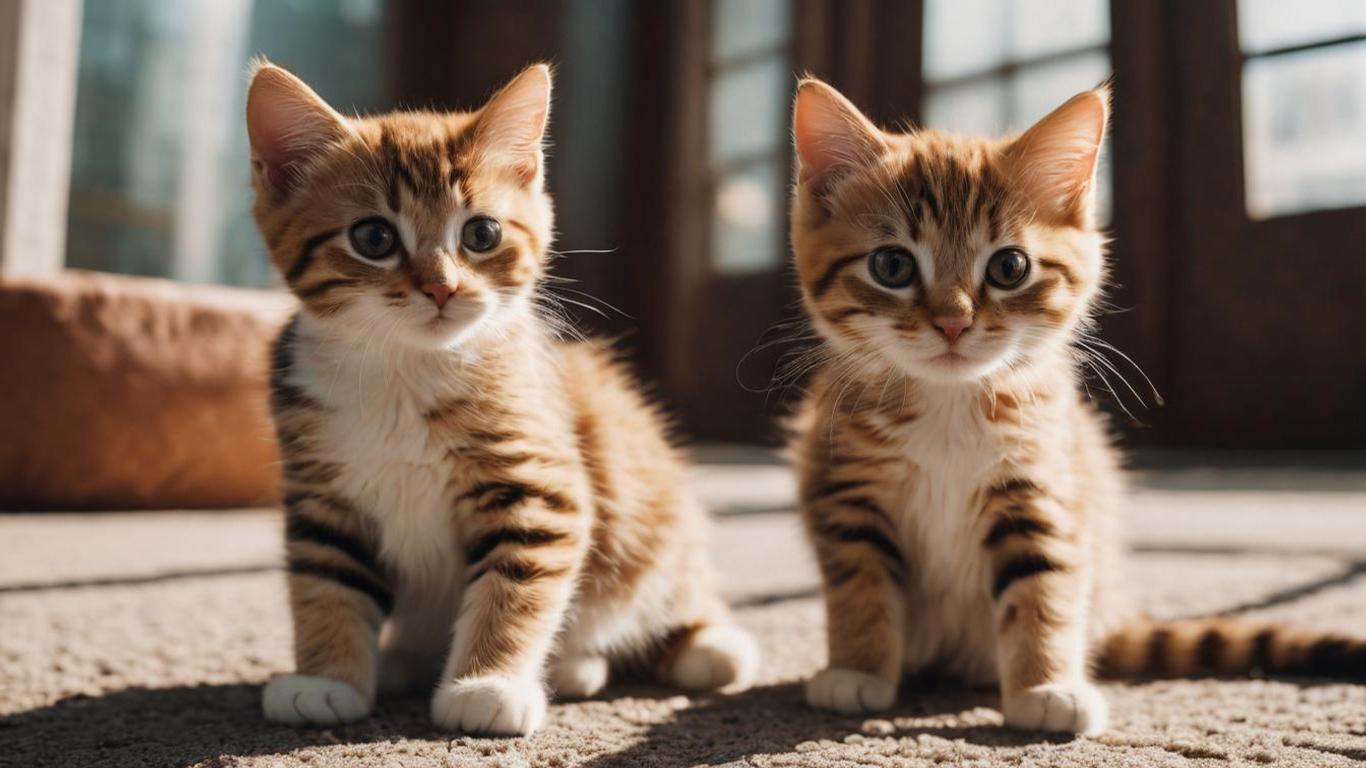
How to Train Cats to Use a Litter Box
Contents
- 1 Why Use a Litter Box for Your Cat’s Bathroom Needs
- 2 What to Consider When Choosing a Litter Box for Your Cat
- 3 Preparing the Litter Box Area for Training
- 4 Introducing Your Cat to the Litter Box
- 5 Choosing the Right Type of Litter for Your Cat
- 6 Teaching Your Cat to Associate the Litter Box with Bathroom Needs
- 7 Encouraging Your Cat to Use the Litter Box Consistently
- 8 Dealing with Accidents Outside of the Litter Box
- 9 Troubleshooting Common Litter Box Training Issues
- 10 Maintaining a Clean and Odor-Free Litter Box
Why Use a Litter Box for Your Cat’s Bathroom Needs
Cats are naturally clean animals, and they have an instinct to cover their waste. This is why providing a litter box for your cat is essential. By having a designated area for your cat to do its business, you can ensure a clean and odor-free home environment.
Using a litter box also promotes good hygiene for both you and your cat. Without a litter box, your cat may be tempted to relieve itself in other areas of your home, such as on your carpets or furniture. This not only creates a mess but also poses health risks as it can introduce bacteria and parasites into your living space. Having a litter box allows for easy cleanup and containment of waste, reducing the likelihood of bacterial contamination and creating a more hygienic living environment for both you and your feline friend.
What to Consider When Choosing a Litter Box for Your Cat
When choosing a litter box for your cat, there are several factors that you need to consider. Firstly, size plays a crucial role in providing a comfortable and spacious bathroom area for your feline companion. Cats prefer larger litter boxes as it gives them enough room to move around and dig. Aim for a litter box that is at least 1.5 times the length of your cat, ensuring they have enough space to comfortably turn around in it.
Another important consideration is the type of litter box. There are various options available, each with its own advantages and disadvantages. Traditional open litter boxes are the most common choice, allowing easy access for your cat. However, some cats prefer more privacy, in which case you might want to opt for a covered litter box. These enclosed options can also help to contain odors. Alternatively, you may consider a top-entry litter box, which helps to minimize tracking and can be useful if you have dogs or curious children in your household. Ultimately, choose a litter box that suits your cat’s preferences and fits well into your home environment.
Preparing the Litter Box Area for Training
When preparing the litter box area for training your cat, it’s important to choose a suitable location that is easily accessible for your furry friend. Opt for a quiet and private area where your cat can have some privacy while using the litter box. This will help create a sense of security and make them feel more comfortable during the training process. Also, ensure that the litter box is placed in a spot that is convenient for you to clean and maintain.
In addition to the location, consider the size and design of the litter box. Make sure it is spacious enough for your cat to comfortably move around in and dig. Cats generally prefer covered litter boxes as it provides them with a sense of privacy and reduces litter tracking. However, some cats may prefer open litter boxes, so observe your cat’s behavior and preferences to determine what type of box they prefer. It’s also a good idea to have multiple litter boxes if you have multiple cats, as some cats may prefer one box over the other. Overall, creating a comfortable and suitable litter box area will set a solid foundation for successful training.
Introducing Your Cat to the Litter Box
When it comes to introducing your cat to the litter box, it’s important to be patient and understanding. Remember, every cat is different and may respond differently to the concept of using a litter box. To start the introduction process, place the litter box in a quiet and easily accessible area of your home. Ensure that the box is large enough for your cat to comfortably move around in. It’s also essential to choose a litter box that is low enough for your cat to easily step in and out of. Place some litter in the box, filling it to a depth of about two inches. This will provide a surface for your cat to dig and bury their waste. Make sure to use a litter that your cat is familiar with or one that closely resembles the texture of the litter they are accustomed to.
Choosing the Right Type of Litter for Your Cat
When choosing the right type of litter for your cat, there are several factors to consider. First, you’ll want to think about the texture of the litter. Some cats prefer a softer texture, while others may prefer a coarser one. It may take some trial and error to find the right texture that your cat is comfortable with.
Another thing to consider is the scent of the litter. Some litters are scented to help mask odors, but this may not be appealing to all cats. If your cat is sensitive to strong scents, it’s best to opt for unscented litter. Additionally, it’s important to note that some scented litters can be overpowering and may deter your cat from using the litter box.
In addition to texture and scent, you should also take into account the type of litter material. There are various options available, such as clay, clumping, crystal, and natural fiber litters. Each type has its own pros and cons, so it’s essential to consider your cat’s preferences, as well as any specific needs or sensitivities they may have.
Lastly, keep in mind the ease of cleaning and maintenance when choosing your cat’s litter. Clumping litters are generally easier to clean, as they form solid clumps when wet, making it easier to scoop out. Non-clumping litters may require complete box changes more frequently. Consider your time availability and willingness to maintain and clean the litter box regularly when selecting the right type of litter for your cat.
Overall, finding the right type of litter for your cat will require some experimentation and observation of your cat’s preferences. Remember to prioritize their comfort and satisfaction, as this will help ensure a successful and stress-free litter box experience for both you and your feline companion.
Teaching Your Cat to Associate the Litter Box with Bathroom Needs
To teach your cat to associate the litter box with their bathroom needs, it is crucial to make the litter box as inviting and accessible as possible. Start by placing the litter box in a quiet and private area of your home, away from busy foot traffic or loud noises. Cats prefer a peaceful and discreet spot for their litter box to feel secure while using it. Additionally, ensure that the litter box is easily accessible for your cat at all times. Avoid moving the litter box frequently, as this can confuse your cat and disrupt their sense of familiarity with the designated bathroom area.
Next, introduce your cat to the litter box by gently placing them inside and allowing them to explore it on their own. It is important to be patient during this process, as some cats may take longer to adapt than others. Encourage your cat to enter the litter box by using their paws to scratch the litter gently and show them that it is a suitable place to eliminate. You can also try using a pheromone spray or placing a small amount of your cat’s urine or stool in the litter box to help them recognize it as their own space. With consistent positive reinforcement and gentle guidance, your cat will gradually learn to associate the litter box with their bathroom needs.
Encouraging Your Cat to Use the Litter Box Consistently
Cats are creatures of habit, and encouraging them to consistently use the litter box requires patience and consistency on the part of the owner. One effective way to promote litter box usage is by keeping the box clean and odor-free. Cats are naturally clean animals, and they are more likely to use a litter box that is free of mess and smells. Scooping the litter box daily and replacing the litter regularly can help create a pleasant environment for your cat and encourage them to use it consistently.
Another way to encourage litter box usage is by providing multiple litter boxes throughout your home. Cats may be deterred from using the litter box if they have to travel long distances to access it. By placing litter boxes in different locations, you are providing convenient options for your cat, making it more likely for them to use one consistently. Additionally, having multiple litter boxes helps prevent competition or territorial issues among cats in multi-cat households.
Dealing with Accidents Outside of the Litter Box
Accidents outside of the litter box can be frustrating for cat owners, but it is important to approach the situation with patience and understanding. If your cat has had an accident outside of the litter box, the first step is to thoroughly clean the area to remove any lingering odors. This will help to prevent your cat from returning to the same spot.
It is also crucial to rule out any potential medical issues that may be causing your cat to have accidents. Schedule a visit to the veterinarian to ensure that your cat is in good health. If there are no underlying health problems, it may be necessary to re-evaluate the litter box setup and training strategies. Making sure that the litter box is easily accessible for your cat and providing positive reinforcement and rewards when your cat uses the litter box can go a long way in resolving litter box accidents.
Troubleshooting Common Litter Box Training Issues
One common litter box training issue that cat owners may encounter is when their cat refuses to use the litter box altogether. This can be frustrating and puzzling for owners who have gone through the process of introducing their cat to the litter box and teaching them to associate it with their bathroom needs. If your cat is not using the litter box, there can be a few possible reasons for this behavior. One possibility is that the litter box may not be clean enough for your cat’s liking. Cats are known for their cleanliness, and if the litter box is dirty or has a strong odor, your cat may choose to find an alternative spot to relieve themselves. Another possible reason is that the litter box may not be located in a suitable area. Cats prefer privacy when using their litter box, so if it is located in a busy or noisy area, they may prefer to find a quieter spot elsewhere.
Another common issue that cat owners may face is when their cat consistently urinates outside of the litter box, even though they use it for bowel movements. This behavior can be especially frustrating for owners, as it can be difficult to pinpoint the underlying cause. One possible reason for this behavior is that the litter box may not be big enough for your cat. Cats like to have enough space to move around and dig in the litter, so if the box is too small, they may not feel comfortable using it for both urine and feces. It is also possible that the litter may not be to your cat’s liking. Cats have individual preferences when it comes to the texture and scent of the litter, so experimenting with different types of litter may help encourage your cat to use the litter box consistently. Finally, stress or changes in the cat’s environment can also cause them to urinate outside of the litter box. Cats are creatures of habit, and any disruptions to their routine or territory can lead to this behavior.
Maintaining a Clean and Odor-Free Litter Box
Keeping your cat’s litter box clean and odor-free is essential for both your feline friend’s comfort and your own sanity. Regular maintenance is key to ensuring a pleasant bathroom experience for your cat and a fresh-smelling home. Start by scooping the litter box daily to remove solid waste and clumps. This will not only prevent odor buildup but also help your cat associate the litter box with cleanliness. Remember to dispose of the waste in a sealed bag to avoid any lingering smells.
In addition to scooping, it’s important to completely change the litter on a regular basis. This typically involves replacing all of the litter in the box once a week or every two weeks, depending on the type of litter used and the number of cats in your household. Remove the old litter and thoroughly clean the litter box with mild soap and water, ensuring it is dry before adding fresh litter. This process helps eliminate any bacterial growth and keeps the litter box fresh for your cat. Finally, consider using odor control products, such as litter box deodorizers or baking soda, to neutralize any remaining odors and maintain a pleasant environment for both you and your furry companion.



Average Rating